Written by Nick Ackerman, co-produced by Stanford Chemist.
abrdn Global Infrastructure Income Fund (NYSE:ASGI) has been continuing to perform quite well since our last update. The discount narrowing based on a new managed distribution policy, which saw the payout increase, is one of the main catalysts to drive that discount narrower. However, a rotation more into defensive sectors has also meant the underlying portfolio performance of this closed-end fund (“CEF”) has also been working well.
Today, the fund remains trading at an attractive discount—even if it isn’t quite as wide as it was previously. This is a non-leveraged fund as well, so this can be a relatively more conservative investment choice overall compared to some of its CEF infrastructure peers.
Saba Capital Management, a closed-end fund activist, owns an ~11.5% stake in this fund. That could have prodded the fund to increase its distribution, or may result in some potential other actions in the future.
ASGI Basics
- 1-Year Z-score: 1.68
- Discount/Premium: -8.31%
- Distribution Yield: 12.95%
- Expense Ratio: 2.05%
- Leverage: N/A
- Managed Assets: $509.425 million
- Structure: Term (anticipated liquidation date around July 28, 2035).
ASGI’s investment objective is “to seek to provide a high level of total return with an emphasis on current income.”
To achieve this objective, the investment strategy is basic. They will “invest in a portfolio of income-producing public and private infrastructure equity investments from around the world.” The largest exposure for this fund remains industrials, as it has tended to be for quite a while with this fund. On the other hand, utilities still make up a meaningful portion of this fund’s portfolio as well.
The fund isn’t necessarily the largest fund in terms of total managed assets, but it should, at some point, get a little larger. That could help provide better daily trading volume to increase the liquidity of the fund. This would come from Macquarie/First Trust Global Infrastructure/Utilities Dividend & Income Fund (MFD) being merged into ASGI. That would help bring in roughly $75 million in net assets as of this writing.
However, this is proving difficult to complete as MFD is a rather tiny fund, and it can be challenging to get shareholders to vote and approve these sorts of deals—that is, even if the shareholders would be better off being merged into ASGI. They have had to adjourn the meeting a total of 7 times so far to allow for more time to get enough shareholders to vote for its approval.
MFD Press Releases (First Trust)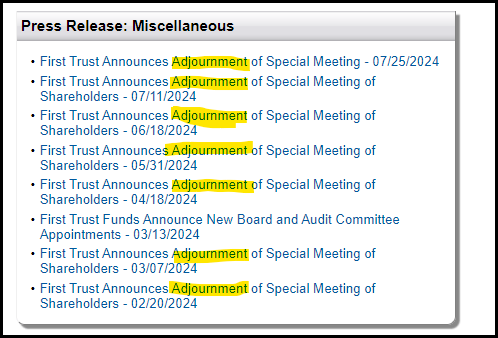
Discount Narrows With Another Managed Distribution Policy Change
We last covered ASGI in early April, along with the BlackRock Utilities, Infrastructure & Power Opportunities Trust (BUI). I believe that both of these funds were attractive choices to consider as we entered into an environment where we were likely to see rate cuts. That said, these are both non-leveraged funds, so they could be considered relatively conservative compared to their leveraged infrastructure CEF peers. They may not participate in as much upside and have that double tailwind of lower borrowing costs, but should things go sideways, they should also be able to hold up relatively better as well.
With all that being said, since that last update, ASGI has performed incredibly well. However, it took a while as the fund moved mostly sideways in the first quarter of the year before seeing a better performance through the second half.
Ycharts
One of the main reasons was the increased distribution rate that the fund was paying. That got income-focused investors excited and pushed that discount to narrow. So it wasn’t only the underlying portfolio performance, but it was helped out by that discount closing as well.
Ycharts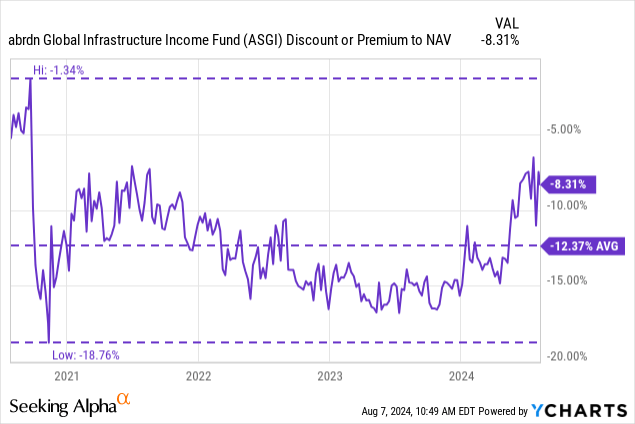
Today, the fund’s discount is still appealing even though it is trading higher than its longer-term average because of the change in the distribution policy. With a higher managed distribution policy, investors are likely to continue to bid shares to around at least these levels, in my opinion.
The managed distribution policy was bumped up at the start of the year to a rolling 9% of NAV payout. This was then increased to a 12% level with an announcement in May. This policy makes it so that the payout can vary from month to month, but as long as this policy is in place, it ensures a relatively high distribution will be paid to investors. Currently, thanks to a still sizeable discount, the fund’s distribution rate comes to 12.95%.
ASGI 1-Year Distribution History (CEFConnect)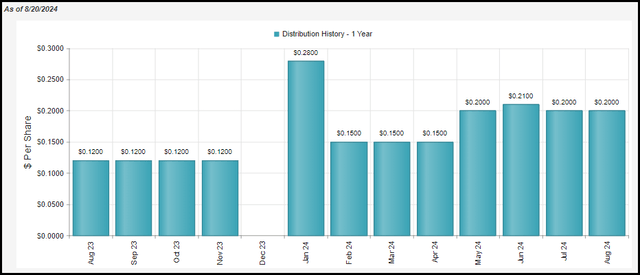
Of course, just because a fund can pay what it’d like does not mean it is actually being earned. I believe that it would be difficult for them to achieve the 9% distribution policy previously over the long term, and that means a 12% policy I would be even more skeptical about.
Remember, it isn’t only the 12% they have to earn but also the fund’s total operating expenses of 2.05% (1.65% excluding deferred tax expenses) on top of that. To be more specific, the total operating expenses would actually be 2.10% without a waiver currently. That fee waiver came as the result of a prior merger with another Macquarie infrastructure fund, but is only in place for twelve months following the closing of the reorganization. That closed on March 10, 2023, which was just in time for this latest semi-annual report to end on March 31, 2024. So, we should expect that the total expense ratio will now be higher.
Anyway, I believe infrastructure is a very attractive place to consider putting capital to work today; the rate of return required might even be hit over the next year or two as rates ease.
However, it is in the longer term that I believe, without an adjustment, where they could find themselves having a difficult time hitting that 13%+ return year-after-year—which is the level required to not see NAV erosion or a steady downward trend of the monthly distribution.
On the other hand, since it is adjusted each month, the NAV erosion can be limited. They may also change the policy in the future at any time.
It is also important to consider, though, that even if they can’t support those types of returns or need to adjust the distribution lower, I still believe that the longer-term performance could still be more than reasonable. Let’s say they can return 8-10% total returns over the long run; that would mean, technically, they aren’t hitting their current managed distribution policy level but still providing respectable results.
To cover the distribution, the fund will require significant capital gains. However, that isn’t unlike too many other equity-focused closed-end funds on the market—even compared to equity infrastructure CEF peers, they all require significant capital gains to fund their payouts.
ASGI Financial Metrics (abrdn)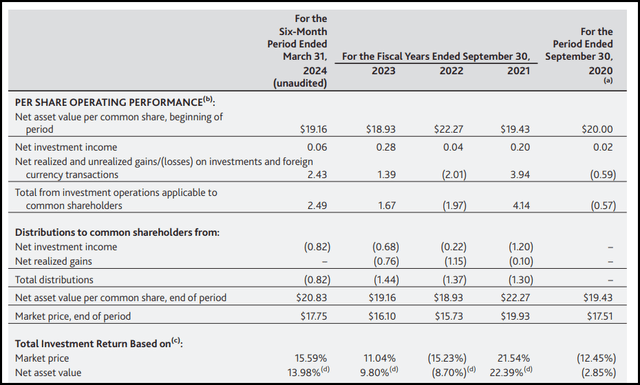
As of their last semi-annual report, net investment income coverage based on what was a lower distribution policy came to just 7.3%. With a now higher distribution policy, we can see that the fund has been paying out ~$0.20 per month, which $0.06 earned in a six-month period wouldn’t even cover barely a quarter of one monthly distribution.
ASGI’s Portfolio
ASGI is an infrastructure CEF, in my opinion, but it does come with a more unique tilt of overweighting industrial exposure. This has been the case since the fund launched, and I began following it. In fact, we’ve seen a bit of an increase in the industrial allocation since our previous update, where industrial was at 30.9% weighting, and utilities were at 32.1%. So we’ve seen industrials now just edge out utilities for the top spot.
ASGI Sector Weightings (abrdn)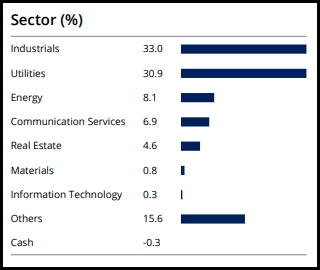
That weighting offsets it from its peers a bit, but this fund also comes with a fairly sizeable allocation to private investments as well. This accounted for 15.5% of the fund’s assets as of their last semi-annual report.
ASGI Private Investments (abrdn)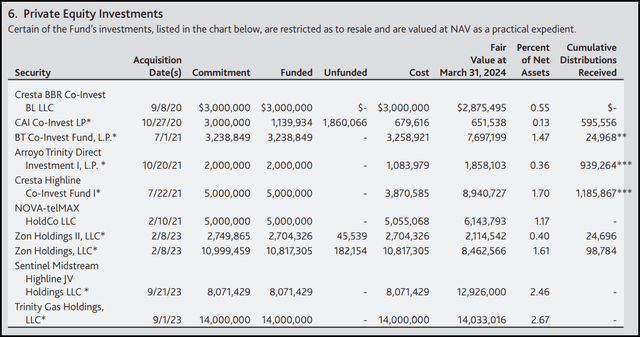
Sometimes, private investments can add a bit of uncertainty to the discount that a fund is trading at. This is because the actual underlying fair value could be suspect as these aren’t securities that trade on an exchange, where fair value can be found immediately and accurately (i.e., something is worth and can be sold for what it is currently trading on an exchange for.) With private investments, it takes a bit of guesswork.
That said, ASGI seems to be one of the better funds that gets updated information fairly regularly. At least from a year ago, the fair value of all these investments has shifted—which makes me believe that the discount on this fund is a bit more reliable. I’ve seen another fund sponsor on one of their funds go well over a year without a change in what they had fair values listed at (though they seemed to correct that with their more recent reporting material.)
One of their newer private investments is Trinity Gas Holdings, which actually makes its way on the list of its top ten holdings in the latest fact sheet.
ASGI Top Ten Holdings (abrdn)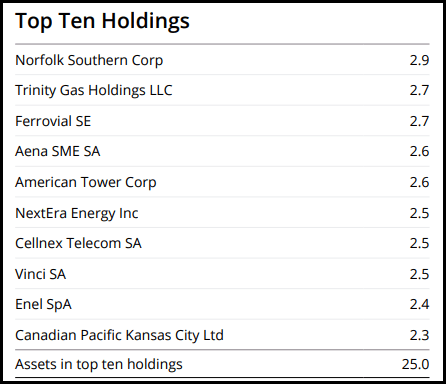
The largest holding in the fund, Norfolk Southern Corporation (NSC), was a portfolio position previously, but it has seen its weight climb higher to take the top spot. Previously, it was Vinci SA (OTCPK:VCISY) that took that place, which remains a top position, but it has slipped in terms of percentage weighting.
Conclusion
ASGI has seen its discount narrow meaningfully since our last update, which helped provide a solid total share price return. However, its underlying portfolio has also been performing well, so that wasn’t the sole driver of the performance. The fund still trades at a sizeable discount, and I believe, combined with a strong outlook for infrastructure to continue to perform well, this makes ASGI a reasonable place to put some capital to work.
Editor’s Note: This article covers one or more microcap stocks. Please be aware of the risks associated with these stocks.
Read the full article here



